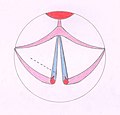Endoscopic laser cordectomy
Endoscopic laser cordectomy is a surgical procedure used primarily in the treatment of laryngeal cancer, specifically early-stage glottic cancer. This minimally invasive technique involves the use of a laser to remove cancerous tissue from the vocal cords, aiming to preserve as much of the healthy vocal cord and surrounding tissue as possible. The procedure is performed through an endoscope, a flexible tube with a light and camera attached, which allows the surgeon to view the vocal cords without making large incisions.
Indications
Endoscopic laser cordectomy is indicated for patients with early-stage glottic cancer, where the tumor is confined to the vocal cords and has not spread to other parts of the larynx or beyond. It is also considered for benign lesions of the vocal cords, such as vocal cord nodules, polyps, and cysts, when other treatments have failed.
Procedure
The procedure is typically performed under general anesthesia. The surgeon inserts an endoscope through the mouth to access the larynx. A laser, attached to the endoscope or used alongside it, is then precisely directed to remove the cancerous tissue. The type of laser used can vary, but the CO2 laser is commonly employed due to its precision and the reduced risk of damaging surrounding tissue.
Advantages
Endoscopic laser cordectomy offers several advantages over traditional open surgery, including:
- Minimized damage to healthy tissue
- Reduced postoperative pain and discomfort
- Shorter hospital stay and quicker recovery
- Preservation of voice quality to a greater extent than with more invasive procedures
Risks and Complications
As with any surgical procedure, endoscopic laser cordectomy carries risks, such as:
- Bleeding
- Infection
- Swelling that could lead to breathing difficulties
- Changes in voice quality, including hoarseness or breathiness
Recovery
Recovery times can vary depending on the extent of the surgery and the individual patient. Most patients can expect to return to normal activities within a few weeks, although it may take several months for voice quality to stabilize.
Conclusion
Endoscopic laser cordectomy is a valuable tool in the treatment of early-stage glottic cancer and certain benign vocal cord lesions. Its minimally invasive nature allows for effective removal of lesions with fewer complications and a quicker recovery time compared to traditional surgery. However, the decision to proceed with this procedure should be made after a thorough discussion between the patient and their healthcare provider, considering the potential risks and benefits.
Transform your life with W8MD's budget GLP-1 injections from $125.
W8MD offers a medical weight loss program to lose weight in Philadelphia. Our physician-supervised medical weight loss provides:
- Most insurances accepted or discounted self-pay rates. We will obtain insurance prior authorizations if needed.
- Generic GLP1 weight loss injections from $125 for the starting dose.
- Also offer prescription weight loss medications including Phentermine, Qsymia, Diethylpropion, Contrave etc.
NYC weight loss doctor appointments
Start your NYC weight loss journey today at our NYC medical weight loss and Philadelphia medical weight loss clinics.
- Call 718-946-5500 to lose weight in NYC or for medical weight loss in Philadelphia 215-676-2334.
- Tags:NYC medical weight loss, Philadelphia lose weight Zepbound NYC, Budget GLP1 weight loss injections, Wegovy Philadelphia, Wegovy NYC, Philadelphia medical weight loss, Brookly weight loss and Wegovy NYC
|
WikiMD's Wellness Encyclopedia |
| Let Food Be Thy Medicine Medicine Thy Food - Hippocrates |
Medical Disclaimer: WikiMD is not a substitute for professional medical advice. The information on WikiMD is provided as an information resource only, may be incorrect, outdated or misleading, and is not to be used or relied on for any diagnostic or treatment purposes. Please consult your health care provider before making any healthcare decisions or for guidance about a specific medical condition. WikiMD expressly disclaims responsibility, and shall have no liability, for any damages, loss, injury, or liability whatsoever suffered as a result of your reliance on the information contained in this site. By visiting this site you agree to the foregoing terms and conditions, which may from time to time be changed or supplemented by WikiMD. If you do not agree to the foregoing terms and conditions, you should not enter or use this site. See full disclaimer.
Credits:Most images are courtesy of Wikimedia commons, and templates, categories Wikipedia, licensed under CC BY SA or similar.
Contributors: Prab R. Tumpati, MD


